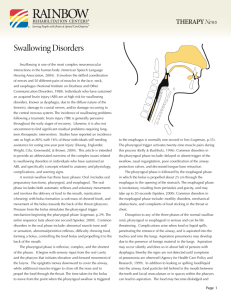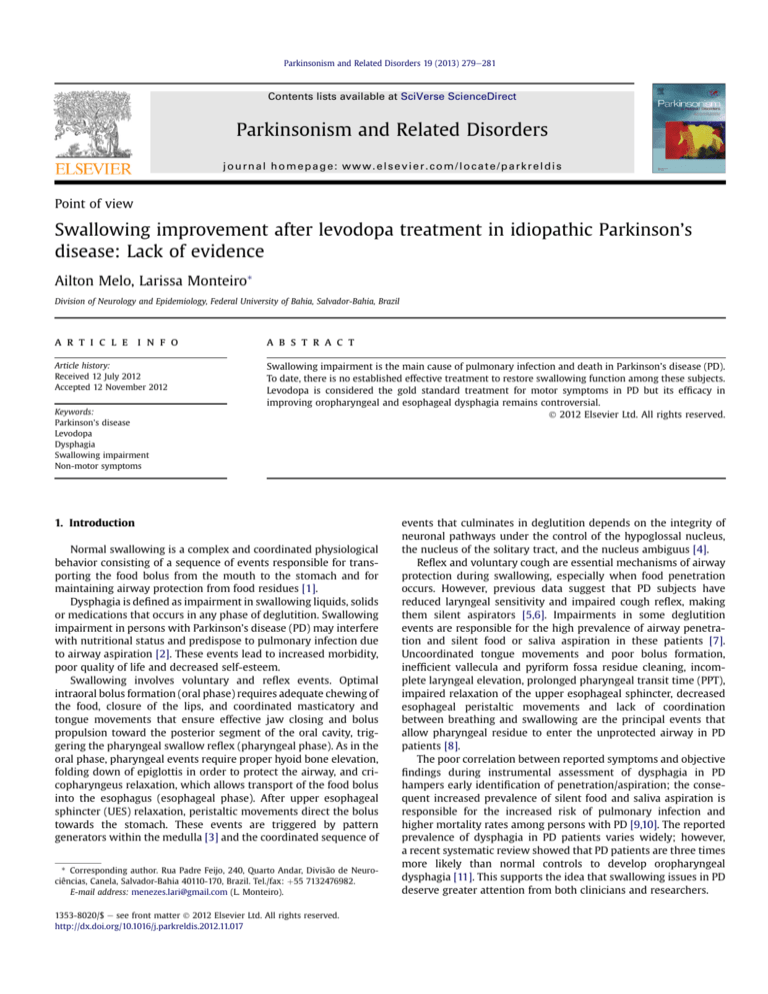
Parkinsonism and Related Disorders 19 (2013) 279e281
Contents lists available at SciVerse ScienceDirect
Parkinsonism and Related Disorders
journal homepage: www.elsevier.com/locate/parkreldis
Point of view
Swallowing improvement after levodopa treatment in idiopathic Parkinson’s
disease: Lack of evidence
Ailton Melo, Larissa Monteiro*
Division of Neurology and Epidemiology, Federal University of Bahia, Salvador-Bahia, Brazil
a r t i c l e i n f o
a b s t r a c t
Article history:
Received 12 July 2012
Accepted 12 November 2012
Swallowing impairment is the main cause of pulmonary infection and death in Parkinson’s disease (PD).
To date, there is no established effective treatment to restore swallowing function among these subjects.
Levodopa is considered the gold standard treatment for motor symptoms in PD but its efficacy in
improving oropharyngeal and esophageal dysphagia remains controversial.
Ó 2012 Elsevier Ltd. All rights reserved.
Keywords:
Parkinson’s disease
Levodopa
Dysphagia
Swallowing impairment
Non-motor symptoms
1. Introduction
Normal swallowing is a complex and coordinated physiological
behavior consisting of a sequence of events responsible for transporting the food bolus from the mouth to the stomach and for
maintaining airway protection from food residues [1].
Dysphagia is defined as impairment in swallowing liquids, solids
or medications that occurs in any phase of deglutition. Swallowing
impairment in persons with Parkinson’s disease (PD) may interfere
with nutritional status and predispose to pulmonary infection due
to airway aspiration [2]. These events lead to increased morbidity,
poor quality of life and decreased self-esteem.
Swallowing involves voluntary and reflex events. Optimal
intraoral bolus formation (oral phase) requires adequate chewing of
the food, closure of the lips, and coordinated masticatory and
tongue movements that ensure effective jaw closing and bolus
propulsion toward the posterior segment of the oral cavity, triggering the pharyngeal swallow reflex (pharyngeal phase). As in the
oral phase, pharyngeal events require proper hyoid bone elevation,
folding down of epiglottis in order to protect the airway, and cricopharyngeus relaxation, which allows transport of the food bolus
into the esophagus (esophageal phase). After upper esophageal
sphincter (UES) relaxation, peristaltic movements direct the bolus
towards the stomach. These events are triggered by pattern
generators within the medulla [3] and the coordinated sequence of
* Corresponding author. Rua Padre Feijo, 240, Quarto Andar, Divisão de Neurociências, Canela, Salvador-Bahia 40110-170, Brazil. Tel./fax: þ55 7132476982.
E-mail address: menezes.lari@gmail.com (L. Monteiro).
1353-8020/$ e see front matter Ó 2012 Elsevier Ltd. All rights reserved.
http://dx.doi.org/10.1016/j.parkreldis.2012.11.017
events that culminates in deglutition depends on the integrity of
neuronal pathways under the control of the hypoglossal nucleus,
the nucleus of the solitary tract, and the nucleus ambiguus [4].
Reflex and voluntary cough are essential mechanisms of airway
protection during swallowing, especially when food penetration
occurs. However, previous data suggest that PD subjects have
reduced laryngeal sensitivity and impaired cough reflex, making
them silent aspirators [5,6]. Impairments in some deglutition
events are responsible for the high prevalence of airway penetration and silent food or saliva aspiration in these patients [7].
Uncoordinated tongue movements and poor bolus formation,
inefficient vallecula and pyriform fossa residue cleaning, incomplete laryngeal elevation, prolonged pharyngeal transit time (PPT),
impaired relaxation of the upper esophageal sphincter, decreased
esophageal peristaltic movements and lack of coordination
between breathing and swallowing are the principal events that
allow pharyngeal residue to enter the unprotected airway in PD
patients [8].
The poor correlation between reported symptoms and objective
findings during instrumental assessment of dysphagia in PD
hampers early identification of penetration/aspiration; the consequent increased prevalence of silent food and saliva aspiration is
responsible for the increased risk of pulmonary infection and
higher mortality rates among persons with PD [9,10]. The reported
prevalence of dysphagia in PD patients varies widely; however,
a recent systematic review showed that PD patients are three times
more likely than normal controls to develop oropharyngeal
dysphagia [11]. This supports the idea that swallowing issues in PD
deserve greater attention from both clinicians and researchers.
280
A. Melo, L. Monteiro / Parkinsonism and Related Disorders 19 (2013) 279e281
2. Levodopa treatment and swallowing improvement in
Parkinson’s disease: actual evidence
Levodopa has been considered the gold standard treatment for
PD since its introduction in the late 1960s. Cardinal motor symptoms
unquestionably are relieved by levodopa administration. However,
the efficacy of levodopa in alleviating autonomic symptoms, such as
respiratory and gastrointestinal dysfunction, is still a matter of
debate. In his 1817 seminal description of what we now know as PD,
James Parkinson included some gastrointestinal features, such as
sialorrhea and impairment in swallowing muscles [12]. In 1970,
Calne et al. first reported that the duration of pharyngeal deglutition
assessed by cineradiography in 18 parkinsonian subjects was not
significantly altered by levodopa therapy [13].
C Oral phase
Abnormal events in the oral phase of swallowing have been reported previously in individuals with PD and may contribute to food
aspiration and pulmonary infection. Employing the modified barium
swallow (MBS) study, Hunter et al. studied 15 PD patients with
symptomatic dysphagia and reported an unexpected increase in total
oral transit time (OTT) for solids following levodopa administration,
although fewer swallow attempts were needed to clear solid bolus
[14]. Fuh et al. analyzed 15 PD patients by videofluoroscopy; 12 presented with swallowing impairment. Of these, half showed no
improvement after levodopa use. After stratifying for deglutition
phases, the most frequently altered events were in the oral phase
(prolonged transit time, tongue elevation preventing bolus movement into the pharynx, oral tremor and reduced anterior-posterior
tongue motion) [15]. Nagaya et al., in a similar study with 16 PD
patients experiencing problems swallowing, detected an increased
frequency of aspiration, as assessed by MBS, in subjects with tongue
residue and repeated tongue pumping motion, compared with
normal controls [16].
Motor fluctuations associated with long term levodopa therapy
may contribute to swallowing impairment in PD patients. Monte
et al. compared the OTT, as assessed by videofluoroscopy, between
controls and both dyskinetic and nondyskinetic PD patients. There
was no significant difference in OTT among the three groups [17].
Tongue bradykinesia may impair food transportation in the oral
phase of deglutition. However, the total oral phase score does not
correlate with speed of tongue movement but with the speed of
mandibular movement, eliciting the hypothesis that the oral phase of
swallowing may be responsive to dopaminergic stimulation, as these
events are under voluntary control [18]. In a pilot study with 10 PD
patients that investigated the integration between swallowing and
respiration before and after levodopa use, the authors suggested that
the risk of laryngeal penetration and tracheal aspiration in qualitative
assessments of swallowing remained unchanged. They also reported
that there were no differences in number of swallows, time taken per
swallow, average time per swallow and swallowing capacity between
“on” and “off” levodopa status [19].
C Pharyngeal phase
Proper sealing of the nasopharynx by the velopharyngeal muscles
and inversion of the epiglottis with suppression of respiratory
movements protect the airway from food penetration during the
pharyngeal phase of swallowing. In a case-control study, Bushmann
et al. performed videofluoroscopy in 20 PD patients and 13 controls
before and 45e90 min after the usual and individualized dose of
levodopa. Swallowing impairment was detected in 15 patients and
in 1 control. The most frequent abnormalities were delayed
swallowing reflex and decreased laryngeal elevation. Five patients
with swallowing impairment showed improvement in swallowing
parameters following levodopa therapy; swallowing deteriorated in
1 patient. Four patients agreed to increase levodopa dosage and
undergo repeat videofluoroscopy. Three did not show improvement;
one had decreased valecular stasis and normalized laryngeal
elevation [10]. When comparing dyskinetic and nondyskinetic PD
patients with normal controls, nondyskinetic subjects displayed an
increased frequency of pharyngeal stasis for thin liquids and solids,
which was significantly related to clinical swallowing complaints [17].
C Esophageal phase
Although oropharyngeal dysphagia accounts for the majority of
clinical symptoms, it is important to emphasize that poor upper
esophageal sphincter (UES) relaxation, with or without incomplete
opening, frequently may be present in PD patients. Ali et al.
analyzed UES opening and relaxation by manometry in 19 PD
patients and 23 healthy controls and reported that PD patients had
reduced UES diameter and higher intrabolus pressure, compared
with normal controls [20]. This abnormality can delay pharyngeal
bolus transportation and increase the frequency of airway aspiration. Prolonged esophageal transit time and a tendency for retention in the lower portion of the esophagus may be present in PD
patients, compared with controls, even in the absence of clinical
symptoms. To date, however, no studies have evaluated the effect of
levodopa on the esophageal phase of swallowing in PD patients.
3. Conclusions
Although several reports support the idea that levodopa therapy
improves swallowing impairment in PD, there is no evidence that the
drug consistently improves deglutition in individuals with PD. Since
dopaminergic replacement may improve posture and respiration
[21], some improvement in deglutition also might be expected;
however, further controlled trials are needed to clarify this issue.
Conflict of interests
The authors declare no conflict of interest in this manuscript.
References
[1] Hamdy S, Aziz Q, Rothwell JC, Singh KD, Barlow J, Hughes DG, et al. The
cortical topography of human swallowing musculature in health and disease.
Nat Med 1996;2:1217e24.
[2] Fernandez HH, Lapane KL. Predictors of mortality among nursing home residents with a diagnosis of Parkinson’s disease. Med Sci Monit 2002;8:CR241e6.
[3] Jean A. Brain stem control of swallowing: neuronal network and cellular
mechanisms. Physiol Rev 2001;81:929e69.
[4] Cersosimo MG, Benarroch EE. Neural control of the gastrointestinal tract:
implications for Parkinson disease. Mov Disord 2008;23:1065e175.
[5] Fontana GA, Pantaleo T, Lavorini F, Benvenuti F, Gangemi S. Defective motor
control of coughing in Parkinson’s disease. Am J Respir Crit Care Med 1998;
158:458e64.
[6] Ebihara S, Saito H, Kanda A, Nakajoh M, Takahashi H, Arai H, et al. Impaired
efficacy of cough in patients with Parkinson disease. Chest 2003;124:1009e15.
[7] Rodrigues B, Nobrega AC, Sampaio M, Argolo N, Melo A. Silent saliva aspiration in Parkinson’s disease. Mov Disord 2011;261:138e41.
[8] Gross RD, Atwood Jr CW, Ross SB, Eichhorn KA, Olszewski JW, Doyle PJ. The
coordination of breathing and swallowing in Parkinson’s disease. Dysphagia
2008;23:136e45.
[9] Nobrega AC, Rodrigues B, Melo A. Is silent aspiration a risk factor for respiratory infection in Parkinson’s disease patients? Parkinsonism Relat Disord
2008;14:646e8.
[10] Bushmann M, Dobmeyer SM, Leeker L, Perlmutter JS. Swallowing abnormalities and their response to treatment in Parkinson’s disease. Neurology 1989;
39:1309e14.
[11] Kalf JG, de Swart BJ, Bloem BR, Munneke M. Prevalence of oropharyngeal
dysphagia in Parkinson’s disease: a meta-analysis. Parkinsonism Relat Disord
2012;18:311e5.
[12] Parkinson J. An essay on the shaking palsy. London: Sherwood, Neely and
Jones; 1817.
A. Melo, L. Monteiro / Parkinsonism and Related Disorders 19 (2013) 279e281
[13] Calne DB, Shaw DG, Spiers AS, Stern GM. Swallowing in Parkinsonism. Br J
Radiol 1970;43:456e7.
[14] Hunter PC, Crameri J, Austin S, Woodward MC, Hughes AJ. Response of
parkinsonian swallowing dysfunction to dopaminergic stimulation. J Neurol
Neurosurg Psychiatr 1997;63:579e83.
[15] Fuh JL, Lee RC, Wang SJ, Lin CH, Wang PN, Chiang JH, et al. Swallowing
difficulty in Parkinson’s disease. Clin Neurol Neurosurg 1997;99:106e12.
[16] Nagaya M, Kachi T, Yamada T, Igata A. Videofluorographic study of swallowing
in Parkinson’s disease. Dysphagia 1998;13:95e100.
[17] Monte FS, da Silva-Junior FP, Braga-Neto P, Nobre e Souza MA, de Bruin VM.
Swallowing abnormalities and dyskinesia in Parkinson’s disease. Mov Disord
2005;20:457e62.
281
[18] Umemoto G, Tsuboi Y, Kitashima A, Furuya H, Kikuta T. Impaired food
transportation in Parkinson’s disease related to lingual bradykinesia.
Dysphagia 2011;26:250e5.
[19] Lim A, Leow L, Huckabee ML, Frampton C, Anderson T. A pilot study of
respiration and swallowing integration in Parkinson’s disease: "on" and "off"
levodopa. Dysphagia 2008;23:76e81.
[20] Ali GN, Wallace KL, Schwartz R, DeCarle DJ, Zagami AS, Cook IJ. Mechanisms of
oral-pharyngeal dysphagia in patients with Parkinson’s disease. Gastroenterology 1996;110:383e92.
[21] Monteiro L, Souza-Machado A, Valderramas S, Melo A. The effect of levodopa
on pulmonary function in Parkinson’s disease: a systematic review and metaanalysis. Clin Ther 2012;34:1049e55.

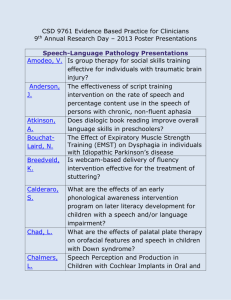
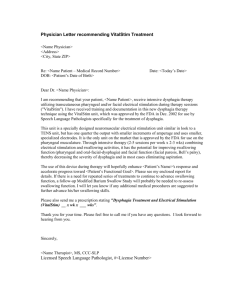
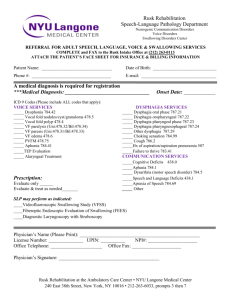
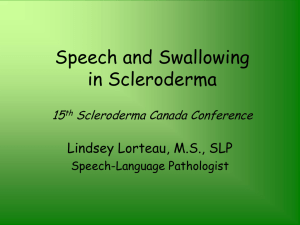
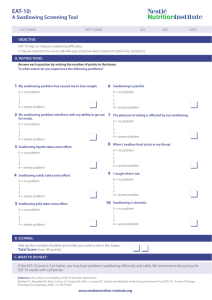
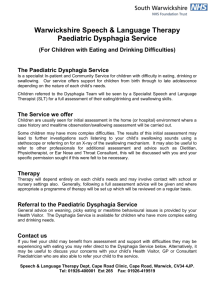
![Dysphagia Webinar, May, 2013[2]](http://s2.studylib.net/store/data/005382560_1-ff5244e89815170fde8b3f907df8b381-300x300.png)
